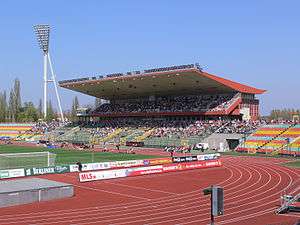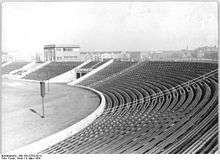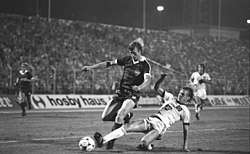Friedrich-Ludwig-Jahn-Sportpark
The Friedrich-Ludwig-Jahn-Stadion at the Friedrich-Ludwig-Jahn-Sportpark is a sports stadium in the Prenzlauer Berg locality in Berlin. It is bordered on the south by Eberswalder Straße, on the north by the Max Schmeling Halle, on the west by the Mauerpark, where part of the Berlin Wall once stood. The complex includes a football and athletics stadium as well as several smaller sports fields. With a capacity of approximately 20,000 seats, of which 15,000 are covered, the stadium is the third-largest in the city after the Olympiastadion and Stadion An der Alten Försterei. BFC Dynamo is currently the main tenant of the stadium, following its 2014 advance to the Regionalliga Nordost.[1] Other tenants are VSG Altglienicke and Berlin Adler. Friedrich-Ludwig-Jahn-Sportpark was the venue for the 2018 World Para Athletics European Championships.
 | |

| |
| Former names | Berliner Sportpark (1951-1952) |
|---|---|
| Location | Cantianstraße 24, D-10437 Berlin, Germany |
| Coordinates | 52°32′35″N 13°24′19″E |
| Public transit | Eberswalder Straße |
| Owner | State of Berlin |
| Capacity | 19,708 |
| Record attendance | 30,000 (East Germany-Belgium, 13 March 1974) |
| Field size | 110 × 72 |
| Surface | Grass |
| Construction | |
| Opened | 1 October 1952 |
| Renovated | 1964, 1970, 1986–1987, 1998, 2015 |
| Construction cost | 15 million Mark |
| Architect | Rudolf Ortner |
| Tenants | |
| BFC Dynamo VSG Altglienicke Berlin Adler | |
History
Before the site was turned into a sports facility, it was used by Prussian Army.[2] The site became the drill and parade ground of the 1st (Emperor Alexander) Guards Grenadiers, after the Prussian miliary had acquired the area from Christian Wilhelm Griebenow in 1825.[3] The site got its nickname "Exer" from the military use. "Exer" is derived from the German word Exerzierplatz, meaning "Parade ground". Some residential buildings were constructed on the site in the late 19th century and the military use came to an end. A training ground was established, which served as the home ground of Hertha BSC (then named BFC Hertha 1892) until 1904.[2] The city of Berlin purchased the land in 1912 and developed it for sports use in 1913.[2]

Berlin was divided after World War II and the site was located in the Soviet sector, in what became East Berlin. The site was developed according to plans by architect Rudolf Ortner for the World Youth Festival in 1951.[2] Several sports, competion and training fields were created, in addition to a large football and athletics stadium with a capacity of 30,000 spectators. Rudolf Ortner had studied at the Bauhaus school until 1933 and left East Germany for West Germany in 1951.[2] The faciliy was initially known as Berliner Sportpark, but the East Berlin City Council decided to name the facility Friedrich-Ludwig-Jahn-Sportpark to honour the centenary of Friedrich Ludwig Jahn. Friedrich Ludwig Jahn is known in Germany as the father of gymnastics.
The Friedrich-Ludwig-Jahn-Stadion has been modernized and expanded several times. A floodlight system was installed in 1964 and a tartan track was added in 1970.[2] The Stadium underwent a complete renovation in 1986-1987.[2] Among other things, a new four story main stand was built, the side opposite the main stand was roofed and new floodlight masts were erected. The current main stand and floodlight masts date from this time.[2] A further renovation took place in 1998, when the stadium received its colorful bucket seats, which are characteristic for the stadium as of today.[2] In order to host the 2015 UEFA Women's Champions League Final, the stadium was renovated at a cost of around € 2 Million. The renovation included new paintwork, new fire doors and a new smoke alarm system, refurbished player and visitor facilities and a new lawn.[4][5][6]
Use of the site
Clubs
BFC Dynamo is the main tentant of the Friedrich-Ludwig-Jahn-Sportpark since the 2014-15 season, as it was from 1971 to 1992. VSG Altglienicke was added as a second main tentant in the 2017-18 season, as the Stadion Altglienicker with its artificial turf did not meet the requirements for matches in the Regionalliga.[7] American football club Berlin Adler plays American football matches in Friedrich-Ludwig-Jahn-Sportpark and the grounds of the facility are also used by football clubs SV Empor Berlin and FC Bundestag.
Football
The Friedrich-Ludwig-Jahn-Stadium was the home ground of army sponsored FC Vorwärts Berlin and its predecessors from 1953. ASK Vorwärts Berlin, and then FC Vorwärts Berlin, was one of the strongest football teams in East Germany in the 1960s. ASK Vorwärts Berlin hosted Glasgow Rangers at the stadium in the 1961–62 European Cup.

The stadium was taken over by BFC Dynamo when FC Vorwärts Berlin was relocated to Frankfurt an der Oder in 1971. BFC Dynamo played its home matches at the stadium until 1992, with the exception of the 1986-87 season, when the stadium was under renovation.
BFC Dynamo celebrated nine of its ten DDR-Oberliga titles in the Friedrich-Ludwig-Jahn-Stadium and played most of its home matches in the European competitions at the stadium. BFC Dynamo hosted teams such Red Star Belgrade, Nottingham Forest, Aston Villa, Hamburger SV, AS Roma, FC Aberdeen, Werder Bremen and AS Monaco at the stadium during the 1970s and 1980s. The main stand of the Friedrich-Ludwig-Jahn-Stadion was regularly visited by the president of SV Dynamo Erich Mielke during the East German era.[8] Erich Mielke was a football enthusiast who barely missed a home match of BFC Dynamo.[9][10]

The East Germany national football team played ten international matches at the stadium from 1971 to 1990. The friendly match between East Germany and Belgium on 13 Match 1974 set the attendance record for the stadium with 30,000 spectators. East Germany won the match 1-0 with a goal by Joachim Streich. In addition, three finals of the FDGB-Pokal were played at the Friedrich-Ludwig-Jahn-Stadion, in 1965, 1990 and 1991.
_Fu%C3%9Fballspieler%26Mario_Moschi%261936.jpg)
The final of the Berlin Cup has been held at the Friedrich-Ludwig-Jahn-Stadion every season since 1995. The stadium has been used by various clubs in Berlin since German reunification. Hertha BSC II has occationally used the stadium, when its own stadium could not be used due to a high number of spectators expected or for security reasons. Hertha BSC played its opening matches in the of the 1992-93 2. Bundesliga season at the stadium. Hertha BSC also played its match against FK Moscow in the semi finals of the 2006 UEFA Intertoto Cup and has played several matches in the qualifying rounds of the UEFA Cup and the UEFA Europa League at the stadium, most recently against Brøndby IF in the third qualifying round of the 2016-17 UEFA Europa League. Hertha won the match 1-0 and the stadium was sold out with 18,454 specators.[11] 1. FC Union Berlin used the stadium for its home matches against FC Haka and PFC Litex Lovech in the 2001-02 UEFA Cup at the stadium, as the Stadion an der Alten Försterei did not meet UEFA safety requirements.
The following teams have temporarily used the stadium as home ground since the 1990s:
- Berliner AK 07 (then known as Berlin Ankaraspor Kulübü 07) in the 2006-07 NOFV-Oberliga Nord.
- Türkiyemspor Berlin in the 2008-09, 2009-10 and 2010-11 Regionalliga Nord and the 2011-12 NOFV-Oberliga Nord, as the Willy-Kressmann-Stadion did not meet the safety reuirement of the German Football Association (DFB).
- 1. FC Union Berlin in the 2008-09 3. Liga, as the Stadion an der Alten Försterei was under renovation.[12]
- 1. FC Union Berlin II in the 2012-13 and 2013-14 Regionalliga Nordost.
The Friedrich-Ludwig-Jahn-Sportpark was chosen as the venue for the 2015 UEFA Women's Champions League Final.[13] The final was played between 1. FFC Frankfurt and Paris Saint-Germain on 14 May 2015. 1. FFC Frankfurt defeated Paris-Saint German with 2-1. The stadium was sold out and the match was attended 17,147 spectators, including Chancellor of Germany Angela Merkel and UEFA President Michel Platini.[14]
Athletics

The Friedrich-Ludwig-Jahn-Sprtpark hosted a stage in the annual multiple stage bicycle race Peace Race between 1963 to 1977. The stadium also hosted the annual Olympic Day of Athletics between 1963 and 1989. The Olympic Day of Athletics was an athletics competition in East Berlin, modeled on the International Stadionfest (ISTAF) that took place in West Berlin.
The Friedrich-Ludwig-Jahn-Sportpark hosted the 1998 German Athletics Championships and the ISTAF took place at the stadium in 2002 and 2003, during the renovation of the Olympiastadion. The Friedrich-Ludwig-Jahn-Sportpark was also the venue of the 2018 World Para Athletics European Championships.
A total of 18 world records have been set in the stadium. Among others, Uwe Hohn set a new world record when he threw the javelin 104,80 meter before 21,000 spectators during the Olympic Day of Athletics on 20 July 1984. This was the first time a javelin throw had exceeded the 100 meter mark. The display at the Friedrich-Ludwig-Jahn-Sport showed a distance of only 4,80 meter, instead 104,80 meter, as it did not have space for five numbers at the time.[15]
Other sports
The Friedrich-Ludwig-Jahn-Sportpark is regularly used for American football and has served as the home venue for the American football team Berlin Adler since 2004. The stadium was used by the Berlin Thunder of the NFL Europe between 1999 and 2002. The stadium has also been the annual venue of the German Bowl between 2012 and 2018 and was the site of the 2014 Eurobowl Final, where the Berlin Adler defeated the New Yorker Lions with 20-17. Due to refurbishment and redevelopment of the Friedrich-Ludwig-Jahn-Sport, the final of the German Bowl was moved to the Commerzbank Arena in Frankfurt am Main in 2019.
The 2001 Speedway Grand Prix of Germany was held at the Friedrich-Ludwig-Jahn-Stadion, which was the first Speedway Grand Prix-event at a temporary track. The Grand Prix was won by the Polish rider Tomasz Gollob. German rider Robert Barth finished on 14th place. The Friedrich-Ludwig-Jahn-Sporpark has recently also served as a venue for the annual crossfit competition Berlin Throwdown.
Concerts
The Friedrich-Ludwig-Jahn-Sportpark also serves as a concert venue. Michael Jackson performed in front of 35,000 spectators in the stadium during his Dangerous World Tour on 4 September 1992.
Future redevelopment
The stadium is considered to be in a state of decay, satisfying neither current needs nor future plans. In order to host the 2015 UEFA Women's Champions League final, the stadium was temporarily renovated for n cost of around € 2 Million. That was however only a beginning, as the entire area is planned for a future complete redevelopment.[4][6]
The area is highly popular and the needs for sporting facilities in Berlin are many. Even when the stadium is empty, the area around is crowded. The neighboring Mauerpark is popular among the citizens of Berlin. Its flea market attracts more than 40,000 visitors each Sunday.[16] The population pressure of Prenzlauer Berg is also high, with Pankow having the highest birth rate in Berlin.[4] In preparation for the plans, more than 40 users of sport facilities in Berlin have been interviewed.[4]
Being the second largest stadium in the city, in terms of seating capacity, and with the Olympic Stadium often considered too large, the stadium also plays a crucial role for the possibility of arranging major sports events in Berlin.[17] A redeveloped stadium would fit in Germany's bid for hosting the 2024 Summer Olympics or 2028 Summer Olympics.[4] If Berlin is awarded the 2024 Summer Olympics, the stadium is planned to be the center of the Paralympics.[18]
According to a preliminary draft concept, the redeveloped Friedrich-Ludwig-Jahn-Sportpark is to be an inclusion sports facility, which goes beyond simple accessibility. The plan includes new office spaces for associations and clubs in the main stand of the stadium and in new buildings, and possibly a new sports hall for clubs and schools with two or three pitches, one or two artificial turf fields, additional tennis, beach volleyball, and beach football fields. Further plans include a daycare center and a car park that could possibly also serve the popular Max-Schmeling-Halle.[4]
In January 2015, it was reported that the entire cost for the redevelopment of the whole area was estimated at up to €150 million. The redeveloped stadium will have a capacity of 20,000 spectators and offer future second division fit. The stadium will have soil heating, completely new seats, fully covered stands and become barrier-free. The distinctive floodlights will be preserved.[19]
In February 2015 it was reported by the Berliner Zeitung that the Senate of Berlin wants to rebuild the stadium, and that the reconstruction could begin at earliest in 2018 and be completed by 2023.[20] In February 2017, German media reported that the senate is planning to invest €170 million in the redevelopment of the area, including €85 million for a new stadium, and that the current stadium will be demolished by 2020.[21]
Location and transport
The stadium is located in Berlin, in the locality of Prenzlauer Berg, which forms the southern part of the borough of Pankow. The stadium can be reached via the U-Bahn line U2, station Eberswalder Straße, and via the tramway lines M1, M10 and 12.
Gallery
 The Friedrich-Ludwig-Jahn-Stadion after renovation in 1987.
The Friedrich-Ludwig-Jahn-Stadion after renovation in 1987. The main stand in 2006.
The main stand in 2006. One of the floodlight masts in 2014.
One of the floodlight masts in 2014. The Fredrich-Ludwig-Jahn-Stadion during a match between BFC Dynamo and SV Babelsberg 03 on 23 April 2017.
The Fredrich-Ludwig-Jahn-Stadion during a match between BFC Dynamo and SV Babelsberg 03 on 23 April 2017.
Panorama
See also
References
- http://www.fupa.net/berichte/bfc-dynamo-zieht-in-jahn-sportpark-um-137303.html
- Schlehahn, Britt (17 May 2020). "Vor dem Abriss nochmal BFC Dynamo gegen BSG Chemie - Corona verhindert letztes Halali". Sportbuzzer (in German). Hannover: Sportbuzzer GmbH. Retrieved 31 July 2020.
- Wähner, Bernd (17 April 2015). "Christian Wilhelm Griebenow legte den Grundstein für Prenzlauer Berg". Berliner Woche (in German). Berlin: Berliner Wochenblatt Verlag GmbH.
- Bardow, Dominik (11 August 2014). "Umbaupläne: Jahnsportpark soll barrierefrei werden". Der Tagesspiegel (in German). Berlin: Verlag Der Tagesspiegel GmbH. Retrieved 8 August 2020.
- Aulich, Ywe (11 May 2015). "hampions-League-Finale der Frauen: Ladies first". Berliner Zeitung (in German). Berlin: Berliner Verlag GmbH. Retrieved 8 August 2020.
- Meuren, Daniel (13 May 2015). "Trostlose Krönungsstätte". Frankfurter Allgemeine Zeitung (in German). Frankfurt am Main: Frankfurter Allgemeine Zeitung GmbH. Retrieved 8 August 2020.
- "Der Aufstieg zwingt die VSG Altglienicke zum Umzug". Der Tagesspiegel (in German). Berlin: Verlag Der Tagesspiegel GmbH. 8 June 2017. Retrieved 1 August 2020.
- Koch-Klaucke, Norbert (24 July 2020). "„Wir kämpfen gegen den Abriss"". Berliner Kurier (in German). Berlin: Berliner Verlag GmbH. Retrieved 1 August 2020.
- Dennis, Mike (2007). "Behind the Wall: East German football between state and society" (PDF). German as a Foreign Language (GFL). 2007 (2): 49. ISSN 1470-9570. Retrieved 9 June 2019.
- MacDougall, Alan (2014). The People's Game: Football, State and Society in East Germany (1st ed.). Cambridge: Cambridge University Press. p. 24. ISBN 978-1-107-05203-1.
- "AUSVERKAUFT!". herthabsc.de (in German). Berlin: Hertha BSC GmbH & Co. KGaA. 30 July 2016. Retrieved 1 August 2020.
- Gänsrich, Rolf (December 2016). "Bolzen auf dem Exerzierplatz der Preußen". Prenzlauer Berg Ansichten (in German). Berlin: Michael Steinbach.
- "Friedrich-Ludwig-Jahn-Sportpark to stage final". uefa.com. Nyon: UEFA. 16 July 2014. Retrieved 1 August 2020.
- "Champions-League-Finale Last-Minute-Tor lässt Frankfurts Frauen jubeln". Hamburger Morgenpost (in German). Hamburg: Morgenpost Verlag GmbH. 14 May 2015. Retrieved 1 August 2020.
- Holz, Jürgen (21 July 2007). "Jahrhundert-Weltrekord von 1984". Neues Deutschland (in German). Berlin: Neues Deutschland Druckerei und Verlag GmbH. Retrieved 8 August 2020.
- Bardow, Dominik (11 August 2014). "Was wird aus dem Jahnsportpark? - Wende im Gelände". Der Tagesspiegel (in German). Berlin: Verlag Der Tagesspiegel GmbH. Retrieved 31 October 2015.
- Wenck, Dietmar (17 August 2013). "Jahn-Sportpark soll für 30 Millionen Euro saniert warden". Berliner Morgenpost (in German). Berlin: Berliner Morgenpost GmbH.
- "Umbaupläne für Berliner Jahn-Sportpark". stadionwelt.de (in German). Stadionwelt, Sole trader: Thomas Krämer. 23 January 2015. Retrieved 31 October 2015.
- Biekler, Sabine; Loy, Thomas (22 January 2015). "Olympia: 150 statt 30 Millionen Euro für Jahn-Sportpark". Der Tagesspiegel (in German). Berlin: Verlag Der Tagesspiegel GmbH. Retrieved 31 October 2015.
- Aulich, Uwe (2 February 2015). "Jahn-Sportpark wird auch ohne Olympia neu gebaut". Berliner Zeitung (in German). Berlin: Berliner Verlag GmbH. Retrieved 31 October 2015.
- Koch-Klaucke, Norbert (23 February 2017). "Senat pumpt 170 Mio. in den Sportpark in Prenzlauer Berg". Berliner Kurier (in German). Berlin: Berliner Verlag GmbH. Retrieved 6 August 2017.
External links
| Wikimedia Commons has media related to Friedrich-Ludwig-Jahn-Sportpark. |
| Preceded by Estádio do Restelo Lisbon |
UEFA Women's Champions League Final venue 2015 |
Succeeded by Mapei Stadium – Città del Tricolore Reggio Emilia |
